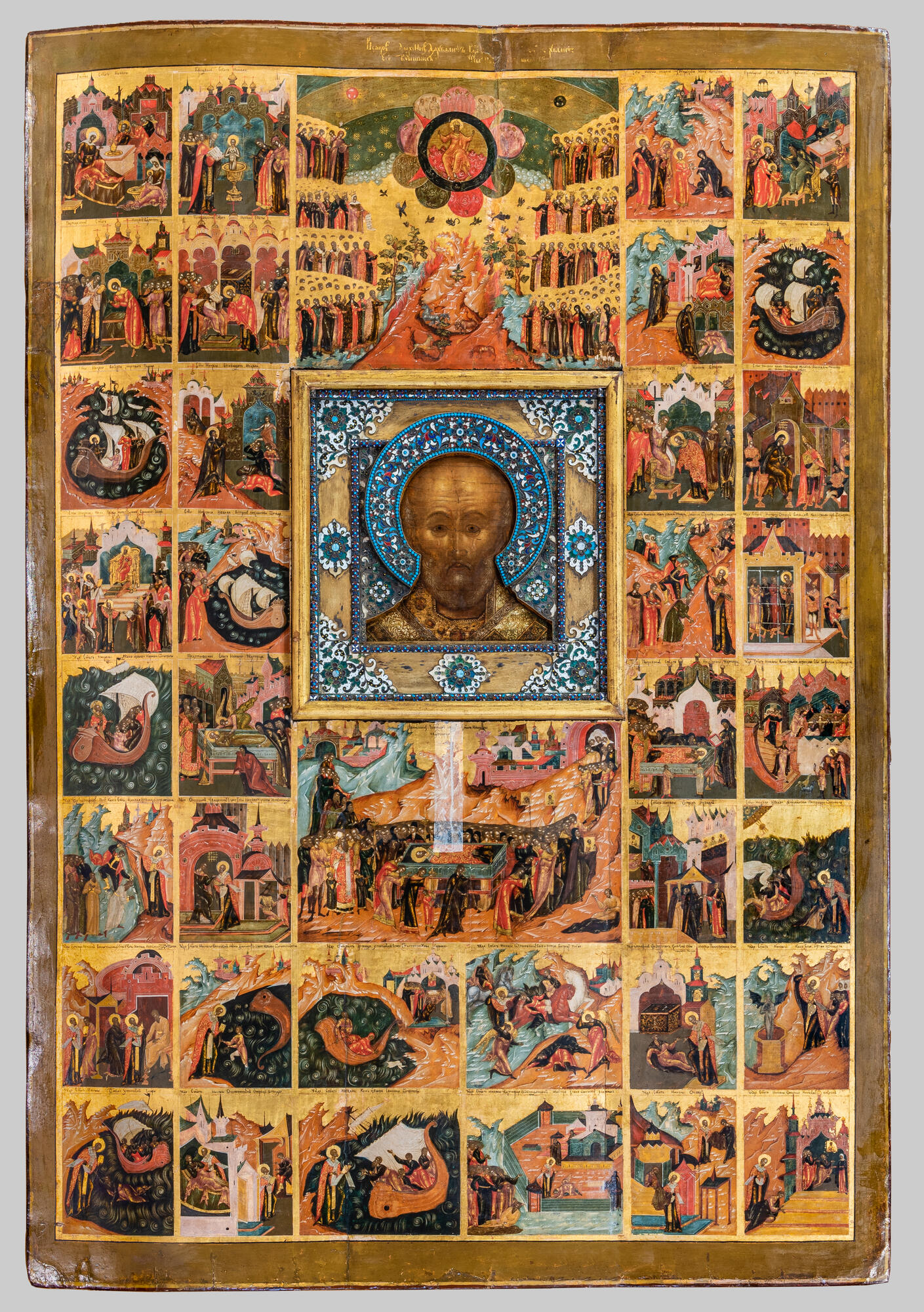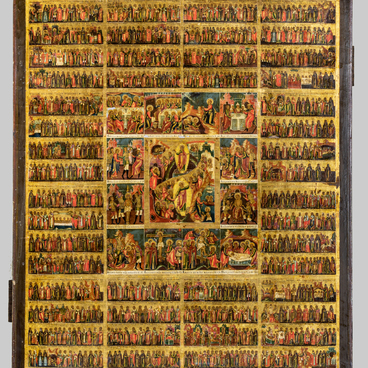The icon The Life and Miracles of St. Nicholas the Wonderworker was created by Palekh artists, who used the icon of Akathist to the Savior as reference. But it was painted a bit later than the Akathist, at the end of the 18th century. In Palekh, it has always been called the ‘Akathist to Nicolas.’ That name was also used by Anatoly Bakushinsky in his book The Art of Palekh.
The centerpiece depicts the face of the saint and is called Nicholas, Shoulder Length. The centerpiece was probably painted by Volga artists in the first half of the 17th century.
The Palekh artists painted 38 border scenes around the centerpiece, depicting separate episodes from the life and miracles of the saint. The one that stands out the most is the composition Let Everything That Has Breath Praise the Lord. Being the icon’s largest border scene, it is placed above the centerpiece. It surpasses in size not only the other border scenes, but even the centerpiece with the face of the saint. The scene is divided into several tiers and depicts the saints praying to Jesus. It got its name from the words of a chant by John of Damascus.
The other border scenes tell about the life of St. Nicholas the Wonderworker. The episodes of “water rescues” are especially plentiful. The compositions have a well though-out structure and do not feel overloaded with elements, although the Palekh artists tried to add as many interesting details to the wonders as possible. The figures of people have slightly elongated proportions and are depicted in relaxed poses.
Even when painted in gold, the background of the Palekh icons is never flat. Many architectural elements have diagonal lines that emphasize depth. The Palekh artist divided the composition into “grounds”: the foreground, the middle ground, and the background. In the street scenes, he managed to convey the height of the sky and the distance to the horizon. Some scenes happen inside buildings. The artist also cut off some of the architectural structures with the upper frame of the border scenes, creating the illusion of an expanding space. Russian icon painters adopted this technique from European prints.
Researchers especially note the color of the icon and its decorative and vibrant style. The light golden color scheme is typical of the Palekh icon paintings of the late 18th century. The authors also used the contrasts of red and green. Each of these colors is represented by a wide range of shades.
The icon’s graphic structure resembles the works of Palekh artists inspired by church hymns.
The centerpiece depicts the face of the saint and is called Nicholas, Shoulder Length. The centerpiece was probably painted by Volga artists in the first half of the 17th century.
The Palekh artists painted 38 border scenes around the centerpiece, depicting separate episodes from the life and miracles of the saint. The one that stands out the most is the composition Let Everything That Has Breath Praise the Lord. Being the icon’s largest border scene, it is placed above the centerpiece. It surpasses in size not only the other border scenes, but even the centerpiece with the face of the saint. The scene is divided into several tiers and depicts the saints praying to Jesus. It got its name from the words of a chant by John of Damascus.
The other border scenes tell about the life of St. Nicholas the Wonderworker. The episodes of “water rescues” are especially plentiful. The compositions have a well though-out structure and do not feel overloaded with elements, although the Palekh artists tried to add as many interesting details to the wonders as possible. The figures of people have slightly elongated proportions and are depicted in relaxed poses.
Even when painted in gold, the background of the Palekh icons is never flat. Many architectural elements have diagonal lines that emphasize depth. The Palekh artist divided the composition into “grounds”: the foreground, the middle ground, and the background. In the street scenes, he managed to convey the height of the sky and the distance to the horizon. Some scenes happen inside buildings. The artist also cut off some of the architectural structures with the upper frame of the border scenes, creating the illusion of an expanding space. Russian icon painters adopted this technique from European prints.
Researchers especially note the color of the icon and its decorative and vibrant style. The light golden color scheme is typical of the Palekh icon paintings of the late 18th century. The authors also used the contrasts of red and green. Each of these colors is represented by a wide range of shades.
The icon’s graphic structure resembles the works of Palekh artists inspired by church hymns.



